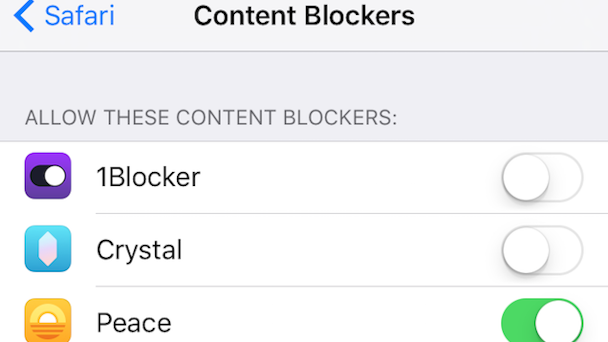Online advertising needs to die: The many upsides of ad blocking
Ad blocking applications are nothing new, despite the recent hysteria over increased adoption amongst desktop and mobile users. Yet it was only after Apple publicly embraced ad blockers via its recent iOS9 update that the digital media industry began expressing its growing anxiety about the potential effect of ad blocking on the free-to-consume business model of content on the internet.

Apple’s decision to promote ad blocking on its iOS9 devices not only intimidated publishers and advertisers; it also legitimized a practice that many of them thus far dismissed as being criminal and unethical.
The panicked reactions of the industry, such as the IAB’s statement that “ad blockers are engaging in highway robbery,” demonstrates that rather than facing the reality reflected from the mirror that their users forced in front of them, some publishers and brands are trying to break that mirror and continue to deny the reasons that made their users take this disruptive action.
Users are conveying a loud and clear message, which the industry can no longer deny: online advertising sucks. It creates a horrible user experience. With industry-wide click-through rates consistently shy of one per cent, current online ad formats are an agony to the “other 99 per cent” of online media consumers. Furthermore, these ads severely diminish web page load times, as The New York Times recently revealed, and position the advertiser and its product or service in a negative light, crowded by fraudulent and misleading ad placements, which are so inefficient, low quality and disruptive that many consumers have become immune to online advertising.
The entire online advertising ecosystem is destroying itself by virtue of commonly accepted digital ad wisdom. As a result, the user experience is poor, which leads more brands to try to shove their message down users’ throats in an aggressive and futile attempt to ensure their ad is seen. All of this ultimately combines to generate lower rates for publishers.
Everyone knows that the digital ad model is broken, but no one does anything about it. Well, now users have.
The practice of ad blocking is aggressive, possibly illegal, and is not constructive to maintaining free content on the internet. Some people have suggested that as ad blocking continues to gain traction, more publishers should implement paywalls to make it clear to users that online content isn’t free. There are very real costs associated with producing, publishing and delivering content. But, as many publishers that have tried to implement online paywalls, only to see them fail spectacularly, have found out, a majority of users are not interested in paying for online content, even if it was ad-free.
Disruption never comes in a gentle, polite, non-intrusive manner. When you want to disrupt an industry, you need to shake it up. You need to take its players out of their comfort zone and force them to face a new reality. When pirated MP3 sharing apps disrupted the music industry in the late-1990s, they also used aggressive and illegal practices. The music industry fought back and was able to stop them, but the effect on the industry and its practices was irreversible. Digital distribution became paramount, process disintegrated and publishers could no longer force consumers to buy a full album but instead embraced consumer demands for the ability to purchase individual tracks. The users had spoken, and the message was heard.
Online advertising is facing a similar challenge. Fighting the ad blockers may delay the inevitable, but will not change the future: online advertising as we know it needs to die, and make way for new models that truly make sense for everyone involved: advertisers, publishers and, above all, consumers.
It will take some time to work out exactly what this new online ad model will look like, but one early prototype is native advertising. Sponsored content that is clearly labeled as an ad, and yet creates a favorable user experience, is far less likely to get blocked than the standard 300x250 display ad. If implemented correctly, sponsored content can be engaging and interesting for the user. Even though its production is less scalable than traditional online ad formats, native ads help increase content engagement rates for the publisher, thus yielding higher online ad rates. Thus, we may not need five, 10 or even 50 ads per page. Instead, publishers can become profitable from few, perfectly produced sponsored content items. User experience … FTW!
People will engage with ads if they are interesting and relevant to them. Digital advertising doesn’t need to be as disruptive and intrusive as it has been for so long. Engaging, shareable formats such as flip cards or countdowns are avenues that enable publishers to deliver powerful storytelling in the digital age.
At the same time, ad blockers should cool their overheated rhetoric about how they are saving the internet. The efforts of some ad blockers to force advertisers to pay to be whitelisted is akin to digital blackmail. The motivation of ad blockers is irrelevant. It is the motivation and actions of users that ultimately will decide the fate of digital publishers and brands.
For years, publishers and advertisers have known that their business models – free content funded by ubiquitous and disruptive online ads – were destroying consumers’ experiences on their sites and with their brands. Now, we have the proof from the rise of ad blockers that things have gone overboard. There will be many benefits from the rise of ad blockers, including better ads. The biggest benefit will be that the traditional digital ad model will eventually die off, replaced by a more engaging – and profitable – user experience.
Shaul Olmert is co-founder and chief executive officer of Playbuzz
